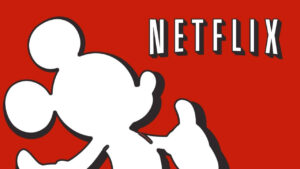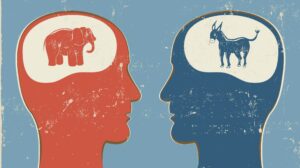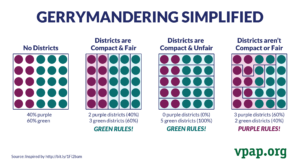Tag: Nicholas Moran ’19
Gerrymandering Distances Officials From Voters
by The Cowl Editor on November 9, 2017
Opinion
Photo Courtesy of VPAP.ORG
by Nicholas Moran ’19
Opinion Staff
Every year, as Rhode Islanders rush to their voting centers for elections, incumbent politicians’ victory parties have already started. Sipping on celebratory champagne in their plush suburban homes, officials can rest easy knowing that no one can seriously challenge their seats.
Why? Stealing tactics from corrupt bookies and old-school wise guys, politicians have discovered a legal fix that puts point shaving to shame, gerrymandering. Supercomputers and expert analysts have packed friendly voters into incumbents’ districts, eroding any chance of competitive elections.
Carving Republicans and Independents out of their districts, Democrats ensured that 86 percent of State Senate seats and 84 percent of General Assembly seats were blue. Yet only 39.9 percent of Rhode Island voters are registered Democrats!
Unfortunately, partisan gerrymandering infects elections across the United States, and both parties reap the rewards at the expense of the American people. With conservatives and liberals jammed into separate districts, red districts elect the same Republicans and blues elect the same Democrats.
Crushing opposition in laughably uncompetitive districts, incumbents no longer have to truly appeal to their voters. All of this destroys voters’ say in their government, weakens their control over their representatives, and allows Congress to stray from the will of the American people. Do not let corrupt politicians fix American Democracy; we must fight to end gerrymandering.
Again, with voters unable to oust complacent representatives from office, a steady stream of inefficient and wildly unpopular policy has spewed from Capitol Hill. According to CNN, Americans of all political leanings gave Congress a miserable 10 percent approval rating, yet these detested representatives easily win reelection. In fact, polls from Public Policy Polling show that the American public has higher approval ratings of traffic jams, herpes, hemorrhoids, and even colonoscopies!
Though the people’s grasp on their democracy continues to wither away, for years the Supreme Court has been unable to declare the corrupt practice unconstitutional. The liberal and conservative wings have bickered endlessly over the constitutionality of the corrupt practice, and the court’s sole swing vote, Justice Kennedy, has been unwilling to end the stalemate.
While Justice Kennedy has spoken out against partisan gerrymandering, he has refused to rule against it without a “manageable standard” to measure it in various districts. Soon the Supreme Court will rule on partisan gerrymandering in Gill v. Whitford, and Justice Kennedy will have the opportunity to deliver gerrymandering’s knockout blow.
Luckily, political analysts have crafted the “efficiency gap” test, the “manageable standard” that Justice Kennedy has been waiting for. As the New York Times describes, the “goal of gerrymandering is to force the other side to waste votes.”
For instance, instead of allowing competitive elections across Wisconsin, Republicans packed Democrats into a few districts, where they cast votes that were far “beyond what’s necessary to win a district.” These districts would have been blue without the extra Democrats siphoned into the district, and these “wasted” Democratic votes could have made other district elections more competitive. With Democrats banished to a handful of districts, Republicans won the majority of districts in landslides.
The “efficiency gap” gives a numeric value to this phenomenon. It tallies “all the wasted votes in victory and defeat for both parties” in packed districts, “finds the difference (between the two parties wasted votes)… and divides by the total number of voters.”
In plsin English, this means that we now have a percentage for how gerrymandered a district is. Using this metric, the New York Times measured Republican gerrymandering in Texas, Ohio, New York, Pennsylvania, Michigan, and six other states. On the other side of the aisle, Democrats have officially gerrymandered Maryland, and have created safe seats in Rhode Island.
Armed with a metric that pinpoints gerrymandered districts, the Supreme Court can finally cleanse the United States of its gerrymandering infection. Finally, Gill v. Whitford could return the reigns of governance to the public, allowing them to expunge complacent and unaccountable representatives from the halls of Congress. End the laughingstock elections; return power to the American voter. To quote Arnold Schwarzenegger, Justice Kennedy, “it’s time to terminate gerrymandering!”
Tangents and Tirades
by The Cowl Editor on October 26, 2017
Opinion

Stop Sexualizing Female Halloween Costumes
What are we trying to tell our girls?
When you are a child, Halloween is about costume parades, trick-or-treating, and haunted houses with friends.
For girls, at some point, they hit an age where that all changes. Halloween becomes about sex and revealing as much of yourself as possible until you are considered “too old” to dress like that.
We have become conditioned to believe that this is just “how it is.”
This is the year 2017, and women have made so many strides in our country. We nominated our first female presidential candidate last year, and we have seen more women in leadership positions this year than ever before.
Even in our Providence College community, for the first time in history Student Congress is run by an all-female executive board.
Despite this evident and continuous growth, when it comes to Halloween, it seems we have made no progress at all.
Type in “adult female costumes,” and what do you see? The images speak for themselves. Every costume seems to have “sex” slapped all over it.
There is not an option to just be a cat as an adult, you must be a “naughty” cat. You cannot just be a nurse, you must be a “sexy” nurse. Do not even get me started on the superheroes, because if you are not a half-naked female superhero, you might as well not be one in the first place.
Why do we continue to sexualize and objectify women through this innocent holiday and when will it stop?
-Kelsey Dass ’18
Ruane Café Needs an Express Line
As students rush to their morning classes, many try to make a stop at the Ruane Café Starbucks to fuel their hectic day. Yet every morning, the line snakes endlessly through the hallway, moving at a snail’s pace.
Even those with 10 minutes to spare are eventually forced to leave for class, so the café loses business and the students walk away frustrated. While long lines in the morning will always be a nuisance, complicated espresso drinks unnecessarily prolong the wait.
Caramel macchiatos and cappuccinos take minutes to make, holding up the line as others desperately need to get to class. Yet ordering a plain hot or iced coffee takes seconds, since all the barista has to do is hand you a cup.
Ultimately, Starbucks can easily avoid this problem by creating an express line for simple coffee drinks. Suddenly grabbing a coffee on the way to class would be possible, as complex drinks would no longer bring the line to a halt.
Now students in a rush can bring their business, and those with time to spare can wait for their drinks in a longer line. Most importantly, the fix is incredibly easy. An additional line would boost efficiency, leave students happy, and allow more cash to pour into the cash register. A win-win.
-Nicholas Moran ’19
Registration 101: A Student’s Perspective
It is that time of year again. No, not fall, or midterms, or being sick. I am talking about the dreaded course registration. Here are a few pointers that will help regardless of your graduating year.
The first thing you want to know is that you cannot prepare too early. Even though registration is in the middle of November, start planning now. Why? There is such a thing as pre-registration, where you are able to get into classes ahead of time according to your declared major. This is a life-saver.
Secondly, I am sure you have heard this one before, but have a ton of back-ups because there is no guarantee that you will get into any of these classes. Next, make an appointment with your advisor as soon as possible. It makes the process a lot less stressful, and that is how you get your ALT pin and pre-registration form.
During registration, the PC Secure Wi-Fi is really slow and busy because everyone else is using it too. Here is a trick: on an iPhone, there is a “Personal Hotspot.” Whenever you don’t have access to Wi-Fi, you can use this and it will allow you to have Internet access on your computer. Yes, it does take up data, but you will only be using it for a few minutes and it is well worth the cost.
Lastly, another tip is to register alone. I know it is fun to share the pain and tears with your roommates when you do not get into the classes you wanted, but this will make your connection worse. Get up early and go to a quiet spot like the Ryan Center or Slavin.
Follow these tips, and your registration will go much better. Good luck!
-McKenzie Tavella ’18
Let Students Study For Midterms
by The Cowl Editor on October 19, 2017
Campus

by Nicholas Moran ’19
Opinion Staff
Besides the hum of the air-conditioning and distant footsteps, the Ruane Center for the Humanities was eerily silent on the night of Columbus Day. A stack of books and pages of class notes sat imposingly in front of me, living proof that my caffeine-fueled night of midterm studying was just beginning.
Yet as the hour hand of my wristwatch cut deeper and deeper into the night, I quickly ran out of places to study. At midnight, a security guard informed students that Ruane was closed, and an hour and a half later the lights in the library began to flicker.
With hundreds of students struggling to study for upcoming midterms, Providence College is failing to provide them with late night study spaces. Why? Instead of sending hard-working students off into the night with nowhere to go, open the library and Ruane all night during midterms to encourage studying.
With an onslaught of blue books and midterm assignments fast approaching, some students are forced to cut their studying short once the library closes. The short hours hit underclassmen especially hard, just as many are preparing to face midterms for the first time.
Luckily for many upperclassmen, apartments provide plenty of space to study without disturbing their roommates, but freshmen simply do not have this luxury. Instead of a spacious library table, a freshman’s small twin bed is their new desk. Studying in a dark and cramped freshman dorm room is near impossible, especially with their roommates trying to sleep feet away from them.
Now they strain their eyes looking at their laptop in darkness, and struggle to read schoolbooks by the faint light of their smartphone flashlight. Ultimately, hard working students deserve better options.
Most importantly, PC can easily remedy these problems by adopting their finals week policy for midterms. During final’s week, the school does a tremendous job in providing ample studying spaces. As the rising sun begins to shine through the library’s windows, students can still diligently study for their exams in the comfort of the library and Ruane.
Those additional hours have been tremendously helpful. Often those early morning hours were when I could put the finishing touches on a final paper, re-read passages, and memorize the last few identifications for a DWC exam. Faced with a mountain of notes and little time to read them, final’s week hours give students a much-needed boost and would do the same for midterms.
Unfortunately for midterm exams, PC only expanded library hours from Oct. 15 to Oct. 24, and it is solely for an additional hour. This extension does not aid students who had exams last week, and provides only slightly more time for this week’s studying.
PC can easily avoid these issues in the future, and final’s week is the perfect blueprint. Allow students to study for midterms in the library and Ruane for as long as they please. Their GPA’s will thank you.
What is Trump’s Foreign Policy?
by The Cowl Editor on September 28, 2017
Opinion

by Nicholas Moran ’19
Opinion Staff
Now that the dust has settled from President Trump’s chaotic United Nations address last week, confused onlookers have been trying to decipher what exactly is the president’s stance on foreign policy.
Was the president suggesting America should pull back from the globe and focus at home, heeding George Washington’s advice to not “entangle our peace and prosperity in the toils of” foreign wars? Or did the president aim to reassure the world that this nation is still a superpower, threatening tyrannical regimes like North Korea and Iran with our military might?
Several newspapers have suggested that Trump is deliberately trying to appear unstable, utilizing Nixon’s infamous “Madman Diplomacy” to frighten America’s enemies and prevent them from provoking the “madman” in the Oval Office.
In reality, President Trump has no clear foreign policy. Once again, the president has given a rambling and incoherent message to the world, full of empty rhetoric and contradictions aimed to appease everyone. Is America still a global superpower or should it put “America first”?
Parts of the president’s speech appeased the worries of Americans weary from wars in Afghanistan and Iraq. The Trump administration does “not seek to impose [America’s] way of life on anyone,” instead this nation shall “respect the interests… [and] the rights of every other sovereign nation.” Now the president “will always put America first… [and other leaders] should put their countries first,” putting an end to America’s global superpower status.
In fact, Trump blasted NATO for being a “one-sided deal where the United States gets nothing in return,” arguing that American involvement in foreign affairs is simply not worth it. Trump implied that making “the world safe for democracy,” as President Wilson famously exclaimed, is great for the world, but is ruinous for our own country.
Instead America should seek diplomacy in “de-escalating” the Syrian Civil War and de-nuclearizing North Korea, leaving our troops on the safety of our shores.
Seconds after Trump railed against past American policy, the president contradicted virtually everything he previously said, proving that his isolationist tirades were nothing but doublespeak. To appease citizens who believe the U.S. should wield its military might as a force for good, President Trump called on our “righteous… [allies] to confront the wicked… [and prevent] evil[‘s] triumph.”
Despots like Raul Castro in Cuba and the Venezuelan regime should tremble at America’s might, as Trump warned of “tough, calibrating sanctions” for ignoring the will of the U.S. Yet all of this directly contradicts his previous promise to respect the “sovereignty” of all nations.
Trump claimed he had been against the War in Iraq since 2003 but threatened to launch conflicts with several nations. For instance, the president promised to “totally destroy North Korea,” ending “rocket man’s… suicide mission” with force if necessary. Moving his sights to the Middle East, the president cried that the “murderous” and “corrupt” Iranians should “fear… the vast military power of the United States,” warning that diplomacy like the “failed” nuclear deal will not be enough.
According to Trump, We must destroy “evil” in Afghanistan, launch missile attacks in Syria, and America shall “crush loser terrorists” by denying “safe havens” in the Middle East. In a mere paragraph, Trump promised to escalate two existing wars and threatened three more.
As Trump moved to trade and foreign aid, once again the president relied on George Orwell’s concept of doublespeak. On the one hand, Trump promised to spend “billions and billions” to solve the refugee crisis, but in the same breath he denounced immigration for hurting “low-income citizens whose concerns are often ignored by both media and government.”
Unfortunately, Trump’s trade message was also unclear, as he promised to both “seek stronger ties of business and trade with all nations” and destroy trade deals like NAFTA that destroy “millions of jobs… factories… [and] our great middle class.” Should we support free trade or protectionism?
Ultimately, American voters deserve more than blatant contradictions and meaningless promises. Trying to appease everyone satisfies no one. What is your real foreign policy, Mr. President?
Tangents and Tirades
by The Cowl Editor on September 21, 2017
Opinion

Peace Makes The World Go Around
We used to speak of the future as something to look forward to, filled with bright and exciting possibilities. Nowadays, conversations surrounding the future are heavy and loaded—filled with rhetoric that incites fear in many.
Recent events with white supremacists, KKK rallies, and terrorism have evoked waves of anxiety and terror in communities across the globe. They have made people wary of the future to come.
As recent as this past Friday, there was a terrorist attack in a London subway station. Fortunately, there were no fatalities, however, 22 people were injured. This is only one among many acts of terrorism in recent years. In fact, this specific attack was triggered by a homemade bomb.
Realistically, it is quite easy to commit a terrorist attack. Nowadays, simply owning a vehicle makes this possible. However, this should not stop people from continuing on with their lives.
By conceding to our fears we are allowing the evil of the world conquer us. It is not okay to stop one’s life because of fear, and the future does not have to be dark.
Only light can drive out darkness and the only way to do so is by maintaining a positive outlook and striving to do good in the world.
It is upsetting to hear so many people discuss how they cannot bring children into the world because of terrorism, but it is through new generations raised correctly that inhumanity can be wiped out; or at the very least, controlled.
It is easy to discuss all the bad in the world and yes, there is a lot of it, but there is more good.
-Laura Arango ’20
Life Without a Meal Plan
Australian millionaire Tim Gurner achieved brief Internet fame when, in an interview with 60 Minutes, he said, “When I was trying to buy my first home, I wasn’t buying smashed avocado for $19 and four coffees at $4 each.”
All right, Tim, you seem a bit sassy and you’ve irritated quite a few people with your comment, but perhaps you have a point. Earlier this week I bought four cans of tuna, crackers in bulk, and a $6 pint of Ben & Jerry’s Non-Dairy P.B. & Cookies ice cream, all in the same purchase.
I am not ashamed, but what my choices in the ice cream aisle at Shaw’s tell me is that 1) I am Tim’s idea of a millennial, spending what little money I have on ridiculously priced food trends and barely subsisting off canned tuna and old mayonnaise.
And 2) I have absolutely no clue how to adult and less of a clue how to survive off-campus without a meal plan. I’ve been meal plan-less for two years now, and let me tell you, the situation has not improved with age, periodic self-reflection, and bouts of honest intent to reform.
While I may technically know how to budget my money and moderate my sugar intake, I do not follow through. My housemates seem to be better at taking care of themselves, as good humans do; they eat salads and make breakfast smoothies and “pack healthy snacks for later.”
I admire them greatly and hope that one day, perhaps in my 60s, I shall have the discipline and self-control to do the same. But for now, my eating habits reflect the fight-or-flight reflexes of the sympathetic nervous system.
Could it be that some suppressed aspect of my childhood makes me feel the need to eat all food in sight? I like to think that my body is subconsciously preparing itself for the impending bomb-shelter life of the North Korea-Trump-pocalypse, I don’t know.
-Lela Biggus ’18
Miserable State of Alumni Hall
As we wind into October, eating at Raymond Dining Hall has already become monotonous. Every week they serve the same few dishes, and the quality is seriously lacking. Stale bread, dry chicken, cold potatoes, repeat.
Even if I am willing to spend money to escape the tedium of Ray, Providence College does not provide many options to spend it on. In fact, PC’s pay-for-food Alumni Dining Hall has only gotten worse.
Since freshman year I have watched the wings and Mexican stations disappear to only have been replaced with one pay option. The burgers are burned. The deli and Italian stations have few choices, and their prices for heroes are higher than actual Italian deli prices.
Even worse, there are virtually no healthy options besides prepackaged salads, and the free meals are bland and unhealthy.
It does not have to be this way, as other colleges provide better options for their students. Brown’s food was ranked by “The Daily Meal” as #19 in the nation, and their dining hall delivers to your dorm room.
Other schools like University of Scranton, Boston University, and Connecticut College routinely get ranked as top in the nation, as their students enjoy better quality food and a plethora of dining options. For instance, Scranton has 11 different dining hall options.
Make no mistake, our dining halls do not have to be this bad. Others do better, and PC must join the trend.
-Nicholas Moran ’19
Stop Streaming From Becoming Cable
by The Cowl Editor on September 14, 2017
Opinion

by Nicholas Moran ’20
Opinion Staff
Frustrated from having to buy expensive cable TV packages filled with unwanted channels, consumers have flocked to Netflix in droves. Media giants watched in horror as thousands of consumers “cut the cord” and escaped from under the crushing weight of their cable bill, leaving the cable TV business in ruin.
Suddenly ratings plummeted, stocks nosedived, and former powerhouse stations, like ESPN, were forced to fire hundreds. Yet now that the dust from the chaos has settled, companies like Disney have discovered a solution.
Instead of letting Netflix stream Disney content, starting in 2019, Disney will launch its own service, joining a growing list of Netflix competitors.
If you want the giant cable bills that Netflix ended to remain things of the past, do not subscribe! Do not let this streaming arms race grow until everyone will have to pay for dozens of services—stop streaming from becoming cable.
Once major Disney movies, like the Star Wars franchise, or Marvel TV shows, like Daredevil, leave Netflix for Disney’s service, some may cave and pay $10 more per month for “just one more.”
Dave Morgan, chief executive officer of marketing technlogy company Simulmedia, told The New York Times that Disney will not be the last new streaming service, because “everyone is arming up.” No one wants to be left out of the streaming boom, especially since the market is filled with youth that could be paying customers for decades.
According to a study reported by CNN, 80 percent of Millennials use streaming, a massive chunk of the largest generation in American history.
With untold riches in their sights, Amazon, Hulu, CBS, and HBO have already “arm[ed] up,” and the list of new services only continues to grow.
Soon “cord-cutters” could be paying $10 monthly to watch sports on ESPN streaming, another $10 each for Facebook and Disney, and additional costs for whoever else joins in on what The New York Times called a “gold rush.”
Yet as each company pulls their content from Netflix and launches a competitor, each service will have less and less content. Netflix has already watched its movie selection wither away, as they now offer 38 percent less of IMDB’s top 250 movies than they did five years ago.
Ultimately, each service may only be able to offer its own original content, pressuring customers to once again pay mammoth bills for a myriad of services so they do not miss out on their favorite shows.
However, the days of paying for thousands of unwanted cable channels do not have to return. If consumers simply refuse to pay for more than a couple of services, companies will be forced to license content to established services like Netflix.
As media analyst James McQuivey told CNN, consumers often cut back on streaming services when they have to “choose from a sea of content [and] reach a point of exhaustion.” All of your favorite shows and movies can remain on just one or two sites, streaming can remain inexpensive, but only if consumers say no to companies like Disney.
Make the decision for yourself, stop the onslaught of new streaming services, stop cable from rearing its ugly head under a different name. Your wallet will thank you.
Tangents and Tirades
by The Cowl Editor on April 6, 2017
Opinion

Going Nuts for PVDonuts
Although I am not a paid sponsor for any bakeries or doughnut shops, I would be doing a great disservice to Providence College and greater Rhode Island community if I did not bring to light the magic that is currently happening at 79 Ives Street, Wednesdays through Fridays, during the hours of 8 a.m.-3 p.m. at one incredible artisanal doughnut shop.
PVDonuts, Providence’s first specialty doughnut shop, is not only drawing attention from their local customers for their amazing doughnut creations, but has also gained widespread recognition from media outlets such as The Boston Globe, Buzzfeed, Daily Mail, Cosmopolitan, and Spoon University. If you have not tried their amazing doughnut creations yet, you are missing out on an amazing culinary experience unlike any doughnuts you have ever tried before.
With locally sourced ingredients, PVDonuts hand makes a wide variety of brioche yeasted donuts, traditional old-fashioned, and even vegan style doughnuts. PVDonuts is a true game changer for anyone looking for a sweet addition to their morning coffee. Their menu changes every month, so customers can expect a wide variety of imaginative flavors. From their ’90s-themed menu of March, including the “Dunkaroo” and “Oatmeal Cream Pie Donut” to their current April menu which includes, “The Elvis” and “Brown Butter Coffee Milk,” PVDonuts has established a sound reputation as a leader of the artisanal doughnut world that everyone should try.
-Sarah Kelley ’18
Lift the Laptop Ban
As we enter April, my notebook and folders are in tatters. Weeks of stuffing them into my packed backpack has shredded my notebook, and my folder is bursting at the seems with useless papers. Sifting through the mess is a nightmare, as important papers are impossible to find. Yet all of this could have been easily avoided! Everything I need could be in one convenient place: my laptop!
For someone as disorganized as myself, my laptop is essential. Everything can be neatly organized in virtual folders, and nothing can be forgotten or lost. Most importantly, I can write legible notes fast without worrying about my awful handwriting.
Yet every semester, a well-meaning professor bans laptops in their class. “Studies show on average they are not good for students,” they say, or “I think they’re distractions.” As noble as their intentions are, they are forgetting that people learn differently.
Everyone is different—it is impossible for studies to show what is good for everyone. Perhaps some find laptops distracting, but they are vital for others who are disorganized or have bad handwriting. Even if someone is irresponsible and spends class zoning out on ESPN, the rest of the class should not suffer for their mistakes. They should suffer the consequences, not others who are missing out on a crucial tool.
-Nicholas Moran ’19
Bring Back the Trees
One of the many great features of the Providence College campus is its vast stretches of greenery, but it is safe to say that the sudden lack of trees is probably not the vision most have in mind. The newfound stumps, particularly the one on Slavin Lawn, ,came as a surprise to many students. Not only has this abrupt change had a negative impact on the aesthetic of the campus, but more importantly on the environment.
When the weather is favorable, it is not uncommon to see students sitting under the shade of the trees, and it is easy to see why. On warm spring days trees are the perfect place to settle down and get homework done. The tree on Slavin Lawn was an especially popular spot for relaxing.
But these trees are more than just a means for students. Every tree that is cut down contributes to the increase in greenhouse gases reaching the atmosphere, leading to air pollution. Additionally, without trees, the soil becomes dry, losing its uniformity and its ability to produce food.
If not carefully done, replanting trees can also be harmful. Leftover sawdust can distort the ratio of carbon and nitrogen, and nitrogen is needed in order for a new tree to grow.
While there may not be an extensive diversity of species, trees are essential to the cultivation and protection of the environment of the campus.
– Hannah Paxton ’19
U.S. Needs to Curb North Korean Aggression
by The Cowl Editor on March 23, 2017
Opinion

by Nicholas Moran ’19
Opinion Staff
What had been a normal day in Hiroshima disappeared in a great white flash, as August 6, 1945 quickly turned into hell on earth. For the past 72 years, the horror of the Hiroshima and Nagasaki bombings has never been forgotten. Yet if the status quo does not change, North Korean dictator Kim Jong-un will have the power to unleash the carnage Japan witnessed over 70 years ago.
Kim Jong-un, a tyrant who, according to a 2016 article by The Guardian, sends 120,000 political opponents to “the most wretched” concentration camps, where they suffer “systematic starvation, torture, rape… executions… [and other] unspeakable atrocities” for standing up to the despot. This is a man who executes opponents with devastating anti-aircraft guns, and who does not think twice about using chemical weapons banned by the Geneva Convention in a crowded airport.
This brutal tyrant absolutely cannot have his hands on nuclear weaponry that can reach the Continental United States, and the United States must be incredibly cautious in preventing this nightmare scenario.
Faced with a growing North Korean nuclear program that already has 10 small nuclear weapons, how bad is the threat now for the U.S. and its allies? And how can it worsen?
According to experts at the Rand Corporation, the Koreans are capable of a nuclear strike in a 500-kilometer range, putting major cities like Tokyo and Seoul and American military bases in Okinawa and possibly Guam in jeopardy. While the Continental U.S. is currently safe, experts for The New York Times warn that the U.S. will be in range by 2026. As North Korea continues its missile tests, the threat only grows.
How can America stop this crisis? Unfortunately, there is no easy answer. Secretary of State Rex Tillerson told reporters on Friday military intervention “is on the table” if North Korea refuses to halt its program, yet a conflict with North Korea would come at heavy cost.
American General Curtis Scaparrotti warned that the conflict “would be more akin to the Korean War and World War II… [than recent wars,] very complex, probably high casualty.” Unfortunately, American war simulations and other experts have painted a similarly grim picture. Faced with certain annihilation, the North Koreans would launch what the Times calls “a full scale, last-ditch effort” to shock their enemies. Artillery would rain on South Korean cities like Seoul, turning it into a lunar landscape.
Other Korean and Japanese cities could face chemical or nuclear strikes, a horrific prospect. Additionally, war simulations show 90,000 American troops would be deployed in a deadly 56-day initial invasion, and if they succeed, they would then have to scour the countryside finding every last North Korean weapon before it falls into the wrong hands.
However, these predictions are still just that—predictions. America has 10 years to use its full diplomatic powers to halt their program before the continental U.S. is in reach, but they must be cautious in avoiding an incredibly costly war. The horrors that thousands witnessed at Hiroshima must never happen again; stopping the North Korean nuclear program will greatly help that cause.
Bursting The Partisan Bubble
by The Cowl Editor on March 2, 2017
Opinion

by Nicholas Moran ’19
Opinion Staff
Weeks of tension between the Trump administration and the press violently exploded on Friday, February 24 as Trump barred CNN, The New York Times, The Los Angeles Times, Politico, and Buzzfeed from an “informal briefing.” As the news dominated headlines, President Trump poured gasoline on the already raging fire by ravaging these outlets on Twitter and at Conservatice Political Action Confrence. It began when Trump tweeted, “FAKE NEWS… @nytimes [and CNN have] become a joke,”calling them “the enemy of the American People!” As irresponsible as President Trump’s behavior is, it is not unique. Ultimately, it is another dangerous step in a trend on both sides of the aisle—partisan bubbles. Americans have been retreating into their ideological corners for 30 years, becoming increasingly extreme and vilifying anyone who disagrees with them. Liberals and conservatives can now craft their own reality on social media to fit their biases, no matter how false or horribly slanted they are.
All of this leaves free speech, open debate, and compromise—the very foundations of our democracy—in the dust. Do not fall into the trap; listen to other points of view and burst the bubble. Debate the other side, as vilifying and silencing opposing points of view is both un-American and solves nothing. With both sides hiding in their bubbles, partisanship has become increasingly extreme over the past 30 years. According to research reported by Amanda Taub of The New York Times, its pull is so strong it now “operat[es] more like racism or sexism… fueling negative or positive views on [other] people.” Whereas “a few decades ago… people’s feelings about their party and the opposing party were not too different,” now they view the other side as the devil. So much so that “people select relationships” based on whether someone leans right or left. Partisanship has suddenly become “a tribe to… [be] a part of,” and the other tribe needs to be crushed. Debate or compromise is impossible; your opponent is the enemy and untrustworthy.
In an atmosphere very much like Yankees and Mets fans arguing during the Subway Series, partisanship has turned debate in the media into a shouting match. For Rudy Giuliani and Sean Hannity in the conservative bubble, liberals upset with the Trump administration are not just concerned citizens who disagree with them. Giuliani describes them as “spoiled crybabies” having “a temper tantrum… [who need] tissues and hot cocoa” because they did not get their way. Even worse, evil reptiles from the “Washington, D.C. swamp [are] rising up” and are egging these “crybabies” on. Yet in the liberal bubble, the rhetoric is just as extreme and hateful. The 45.9 percent of Americans who voted Republican do not just disagree with Michael Moore, who says they are “legal terrorists” hell-bent on destroying our system. In fact, for Bill Maher, if you were still undecided on the election by October, it was because you were “comfortably dumb… [and] too stupid to pick Hillary.”
Worst of all, students at UC Berkeley refused to let the alternative right speak on their campus, resorting to rioting instead of debate. With both sides thinking the other is incompetent and evil, the future of our democracy is at risk. Suddenly, compromise is impossible according to researchers from The New York Times, compromise shows that you are “weak… and a bad member of the tribe.” Things that once would have been bi-partisan, like Russia’s involvement in our elections, are anything but. The GOP ignores it because it is “inconvenient” for their tribe and “Democrats are obviously motivated” because it hurts the enemy. Additionally, partisan bubbles could force politicians to become radical, as Pew Research shows both parties have slid farther towards their extreme wings since 1994. And worst of all, it fuels fake news. Now both sides have “wildly different sets of [sometimes false] facts,” making any sort of agreement impossible. All that is left are two sides endlessly bickering with one another, accomplishing nothing.
Yet there is a way to escape this fate. Understand that disagreement is a sign of a healthy society. Having opposing views does not make the other side evil. Do not leave yourself trapped in an echo-chamber of people who agree with you; burst the bubble and stop this downward spiral.

